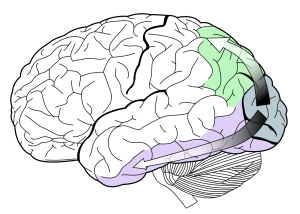Visual Development and Object Recognition
111
Learning Objectives
Know what the dorsal and ventral pathways in the visual cortex are.
Know what the anatomical and functional differences are between the dorsal and ventral pathways.
Be able to list some brain regions in both pathways.
Complex computations relating to vision, those that eventually allow you to have a visual experience of the world, all happen in the cortex. The first stop in the cortex is at the primary visual cortex (also known as V1). Here, the “reconstruction” process begins in earnest—based on the contrast information arriving from the eyes, neurons will start computing information about color and simple lines, detecting various orientations and thicknesses. Small-scale motion signals are also computed (Hubel & Wiesel, 1962). The computation of motion and aspects like color are what give rise to the ventral and dorsal pathways of vision.
Visual-recognition areas are located along the ventral pathway of the brain and terminate around the temporal lobe (the What pathway). Information that is funneled through this pathway is focused on identifying what a specific object is. Identification relies on multiple brain structures. The fusiform face area specializes in identifying objects for which fine discriminations are required, like faces. There is even a brain region specialized in letter and word processing called with visual word form area. These are just a few important brain regions in the ventral pathway of vision in the brain.
Brain regions along the dorsal pathway, near the parietal lobe (Fig.11.4.1), (or Where-and-How pathway) will compute information about self- and object-motion, allowing you to interact with objects, navigate the environment, and avoid obstacles (Goodale and Milner, 1992). Some major structures in this pathway include the medial superior temporal region and basic parietal regions, both of which play a major role in determining optic flow.

Exercises
- Which answer fills in the blanks the best? The _______ pathway (also known as the Where-and-How pathway) will compute information about self- and object- motion to allow you to navigate and interact with the environment while the _________ pathway (also known as the What pathway) will compute information to identify what a specific object is.
A. Ventral; Dorsal
B. MT; MST
C. Dorsal; Ventral
D. MST; MT
Answer: C
CC LICENSED CONTENT, SHARED PREVIOUSLY
NOBA, Vision
Provided by: University of Illinois at Urbana-Champaign
URL: https://nobaproject.com/modules/vision
License: CC BY-NC-SA 4.0
Adapted by: John Taylor

